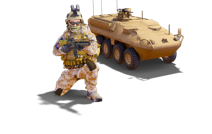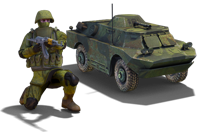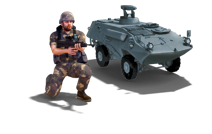Difference between revisions of "Mechanized Infantry"
From Conflict of Nations Wiki
| Line 6: | Line 6: | ||
[[File:Mechanized infantry 1 big.png|left|thumb|Western Mechanised infantry]] | [[File:Mechanized infantry 1 big.png|left|thumb|Western Mechanised infantry]] | ||
| − | [[File:Mechanized infantry 2 big.png| | + | [[File:Mechanized infantry 2 big.png|left|thumb|Eastern Mechanised infantry]] |
[[File:Mechanized infantry 3 big.png|right|thumb|EU Mechanised infantry]] | [[File:Mechanized infantry 3 big.png|right|thumb|EU Mechanised infantry]] | ||
Revision as of 06:06, 1 November 2017
Mechanized infantry are infantry equipped with armored personnel carriers (APCs) or infantry fighting vehicles (IFVs) for transport and combat.
Mechanized infantry is distinguished from motorized infantry in that its vehicles provide a degree of protection from hostile fire, as opposed to "soft-skinned" wheeled vehicles (trucks or jeeps) for motorized infantry. Most APCs and IFVs are fully tracked or are all-wheel drive vehicles (6×6 or 8×8), for mobility across rough ground. Some nations distinguish between mechanized and armored infantry, designating troops carried by APCs as mechanized and those in IFVs as armored.
Compared with "light" truck-mobile infantry, mechanized infantry can maintain rapid tactical movement and, if mounted in IFVs, have more integral firepower. It requires more combat supplies (ammunition and especially fuel) and ordnance supplies (spare vehicle components), and a comparatively larger proportion of manpower is required to crew and maintain the vehicles. For example, most APCs mount a section of seven or eight infantrymen but have a crew of two. Most IFVs carry only six or seven infantry but require a crew of three. To be effective in the field, mechanized units also require many mechanics, with specialized maintenance and recovery vehicles and equipment.


